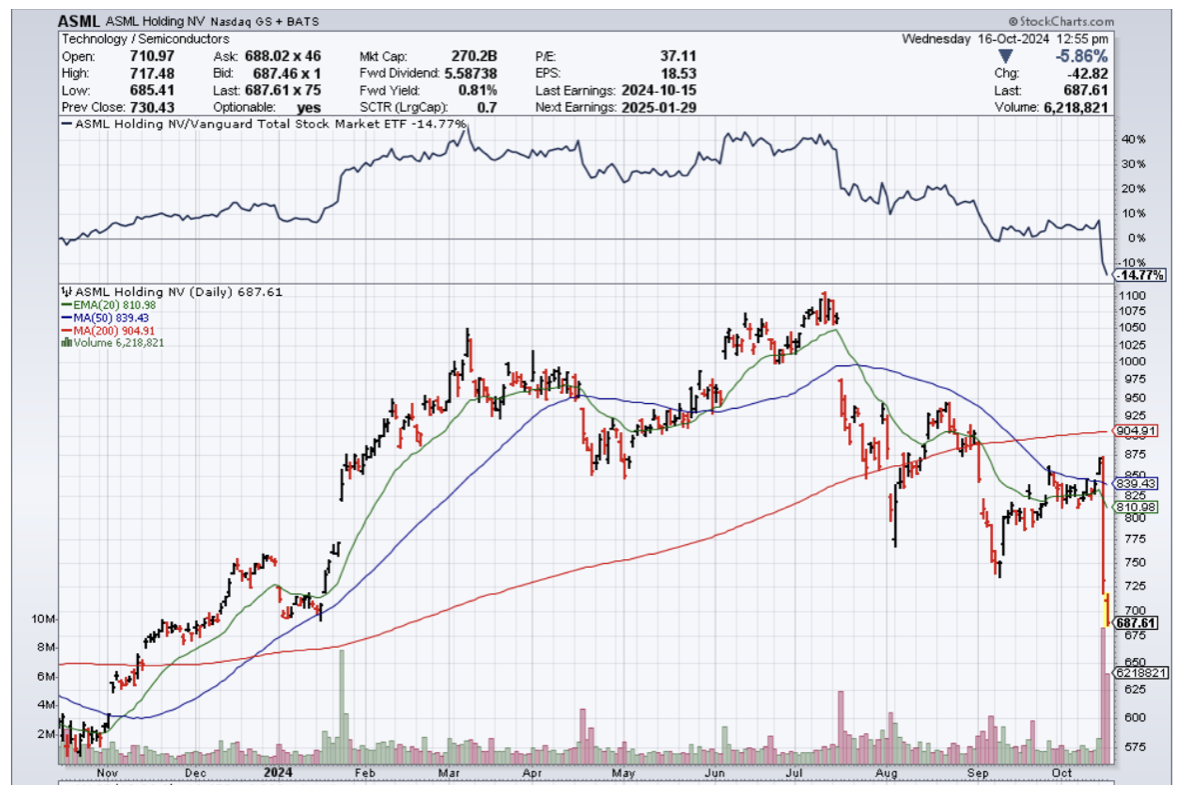Mad Hedge Technology Alerts!
Mad Hedge Technology Letter
October 16, 2024
Fiat Lux
Featured Trade:
(THE CHIP TRADE IS STILL IN-TACT)
(ASML)
Computer chip equipment maker ASML said they will cut 2025 financial guidance, citing weakness in markets other than AI and delayed orders.
This triggered a steep sell-off in many chip names, and I view this as a healthy event.
We are bombarded with so much robust news from the chip sector that it is hard for investors to catch their breath before the next spike higher in underlying shares.
Once in a while, it is highly positive to recalibrate momentum and allow the stock to settle.
Chips are definitely boom-and-bust stocks, and we are right in the middle of the boom. and I wouldn’t be too worried for other chip companies as we head into earnings.
This is a great chance to buy the dip in many of the best of class.
Europe's most valuable technology company, ASML, as an essential supplier to chipmakers, is not in question. But doubts have emerged over short-term sales and, for the longer term, whether it can continue to outgrow the overall market.
ASML's dominance of the market for lithography tools needed to create circuitry triggered the stock to all-time highs before this recent weakness.
After the health crisis of the early 2020’s, customers stopped overbuying, which reduced demand.
Now, ASML said some customers had announced delays of new plants and upgrades, including makers of the logic chips used in smartphones, PCs, and other devices.
Manufacturers that make the memory chips that go into them also plan fewer expansions, meaning they can rely on existing equipment for longer.
That's especially the case for an upstream equipment supplier highly reliant on the spending plans of its manufacturing customers.
It’s highly likely that Taiwan Semiconductor was the company who decided to cut back on business with ASML.
TSMC has been spending rather low capex numbers so far this year, and they may do so again next year because their overall (plant) utilization is not as good as their sales numbers suggest.
Among ASML customers that make logic chips, Intel said in August it would cut capital spending by $10 billion in 2025, while Samsung has said it faces challenges at the factory it is building in Texas.
Roughly a quarter of chipmakers' spending on tools goes to ASML, though some analysts say changes in chip-making techniques could lead that to be lower.
Management also said that customer delays are also a negotiating tactic that may force pricing concessions from ASML, squeezing margins.
Ultimately, this is a temporary demand adjustment after years of outperformance, and I would allow the seasonality to work itself through the system.
I see no threat to the overall business model of ASML, and if bad news on ASML triggers hits to other great chip stocks, I would look at some short-term bull call spreads on strong chip stocks in the US.
At the very least, if you don’t buy the dip, don’t take the other side of the trade because, more often than not, this type of price action sets up a “rip your face off” rally to the upside.
Mad Hedge Technology Letter
October 14, 2024
Fiat Lux
Featured Trade:
(GREAT POTENTIAL FOR A TECH SUB-SECTOR)
(CIBR)



